This post may contain affiliate links. If you use these links to buy something we may earn a commission. Thanks.
The best edible herbs that grow in rocky soil are not only tasty but are gorgeous and beneficial companions in the garden! Each herbaceous perennial tolerates rocks in soil and even shallow soil among larger rocks.
Whether you direct sow or transplant your herbs from seedlings, proper care will allow them to thrive in rocky soil even before they are established.
Most herbs that do well in rocky areas have a level of tolerance to drought, but keeping them well watered for the first year will speed up root development resulting in a healthier plant for all following years.
To encourage even greater success, dig up larger rocks and bring them to the surface. You’ll offer more space in the soil for root growth and better temperature regulation for the area.
If herbs don’t fill up enough space for you, you can also choose from a large variety of ground covers.
See: 36 Best Ground Covers & Plants To Grow in Rocky Soil
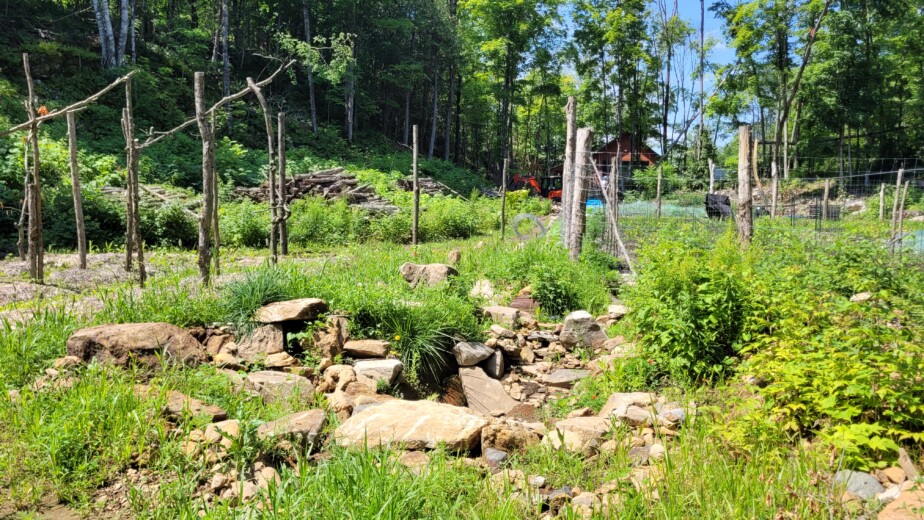
Water and space (even amendment) are particularly important for success when planting in shallow soil. Creeping thyme is likely the most resilient choice for very shallow soils—if making space or amending the soil isn’t an option.
The less amending you do in shallow soil for a new plant the more water you’ll need to stay on top of to help it get established and not dry out. Once established after a year or so, the plant can find water from deeper areas and live without regular manual watering.
I separated these 21 tasty herbs into two categories:
- 11 herbs that grow well in both shallow soil (on rocks) and deep rocky soil
- 10 herbs that grow in deep rocky soil (some may still tolerate shallow soil with proper care, but are less likely to thrive without more depth)
We have both types of rocky soils (shallow and deep) and have attempted to grow 96% of plants on this list in each environment. Based on their performance, with proper care, we have been able to sort this list accordingly.
Herbs can become very costly if you’re looking for a number of them. Even if you just want a couple, they are worth growing from seed, not only for the money savings but the reward of growing your own little plant from scratch.
Disclaimer: Food Forest Living or its authors are not responsible for what you choose to consume. Do your own research before consuming as an “edible” or using any herb for medicine. Before planting any of these options check with your local invasive plant council or regional extension office for guidance on plants that may be invasive in your area.
11 best herbs to grow in shallow and rocky soils
These first ten herbs grow well in any rocky soil and are low maintenance once established.
The more soil they get, the quicker they thrive so if you have the opportunity to amend, add more soil, or dig up rocks to make more space, take it. It’ll be better for you and the plant long term.
Most of the herbs in this list are very commonly planted together in groups. So if you’re after a rocky herb garden, this is a full list of everything you could include!
They all grow well together, but in general, I’d place shallow-rooted herbs with deeper-rooted herbs side by side. Deeper-rooted herbs will mine nutrients below the rocks and drop their leaves to provide nutrients to the surrounding shallower-rooted plants that mine nutrients from the surface.
Thyme (Zones 4-10)

Thyme is known to be adaptable and to prefer well-draining soil. Rocky soil is generally well draining as sediment from stone makes for larger particles in the soil.
Rocks also absorb and retain heat causing the water in the surrounding surface soil to evaporate quicker than non-rocky soils. Thyme tolerates drought and loves heat and full sun.
Finally, since rocky soils don’t tend to be waterlogged, the pH is more likely to stay in the range favorable to thyme—thyme prefers a soil pH of 6.0-8.0.
Creeping thyme is usually the best option for shallow rocky soil and has gorgeous colored flowers.
The small but lush leaves of time make it a stunning low grower. Gaps and crevices are filled by creeping thyme and as it establishes you’ll have a uniform carpet of green (and pink or white when in flower).
If you like the idea of a low-growing carpet—plenty of ground covers thrive in rocky soils.
See: 36 Best Ground Covers & Plants To Grow in Rocky Soil
Any crops prone to pests or disease would benefit from growing near thyme. Pollinators are attracted to the flowers and pests are confused by the scent. Deer have never eaten our thyme and we have lots of deer who frequent our yard.
Order deer-resistant shrubs, herbaceous perennials, bulbs, roses, and ground covers all in one place.
Use thyme in cooking, teas, tinctures, and more for various benefits or flavors.
Rosemary (Zones 6-10)
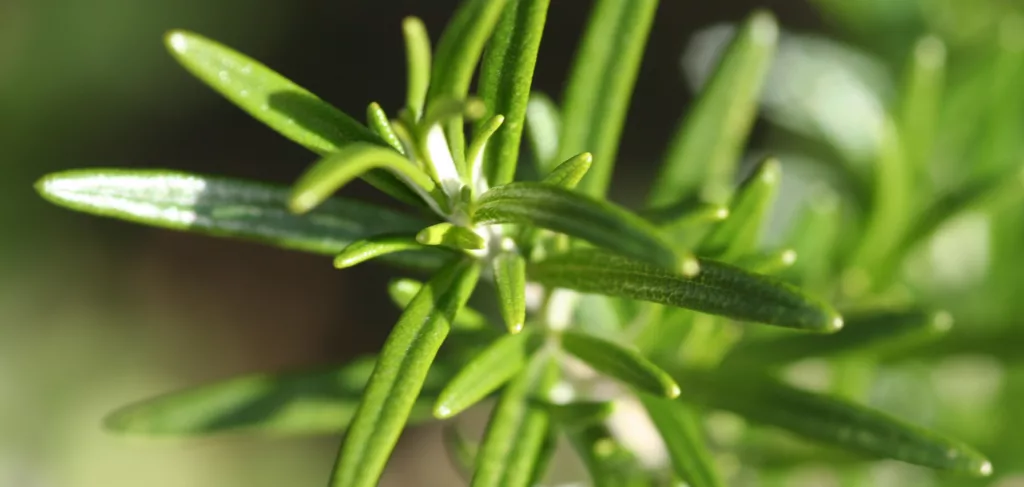
Rosemary is generally adaptable to several soil types and rocky soil is included. Even shallow soils are tolerated since they can still thrive in nutrient-limited areas.
Tolerance to drought also makes this plant a good fit for shallow soils surrounded by rock since that’s a recipe for dryness!
The main reason rosemary is so resilient in these ways is due to its deep root systems. Rosemary isn’t a camel as succulents are, so you’ll still need to care for rosemary while it’s freshly planted until established.
After a year or two of close care, watering, and growth, your rosemary will be equipped with the roots it needs to find water and nutrients below the rocks and shallow pocket you’ve planted in.
Order rosemary seeds.
The other benefit of planting rosemary among exposed rocks—for those of us in zones 5 and 6—is they retain heat and over winter retaining the heat from the sun during the cold months may create a microclimate where it can survive in these colder zones.
Rosemary has gorgeous thin foliage of blue-silvery color and in warmer climates it’s evergreen.
I love drinking rosemary tea since it’s not only delicious but offers a host of medicinal benefits.
The fragrance is another bonus to any garden and acts as a ‘scent confuser’ for deterring pests from other susceptible crops when planted nearby. Deer have never eaten our rosemary although plenty wander through often.
See: How To Map Out Your Food Forest (Full Walkthrough)
Sage (Zones 4-10)
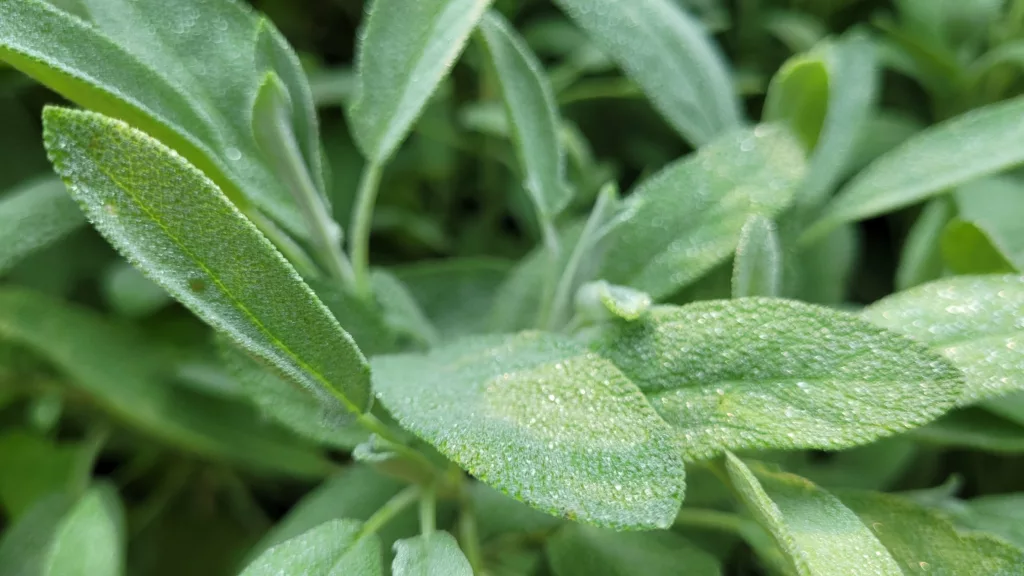
Sage has been the easiest to grow, and I grew all of mine from cheap seed packets from a small business. Today, I enjoy sage tea more often than rosemary tea—sage is my favorite to drink!
Sage also grows deep root systems beyond the surface rocks. Water is also conserved in the soft leaves and can tolerate nutrient-poor pockets.
This silvery-grey-green herb will grow strong and live for years! Getting bigger every year, you’ll have a year’s worth of sage after the second season if you plant 2-3.
Cabbage and carrots are protected by sage if nearby since their strong scent deters and confuses carrot flies and other pests that tend to go after brassicas. Deer have never touched our sage and they’ve been hungry enough to eat spring onions before!
Oregano (Zones 4-9)
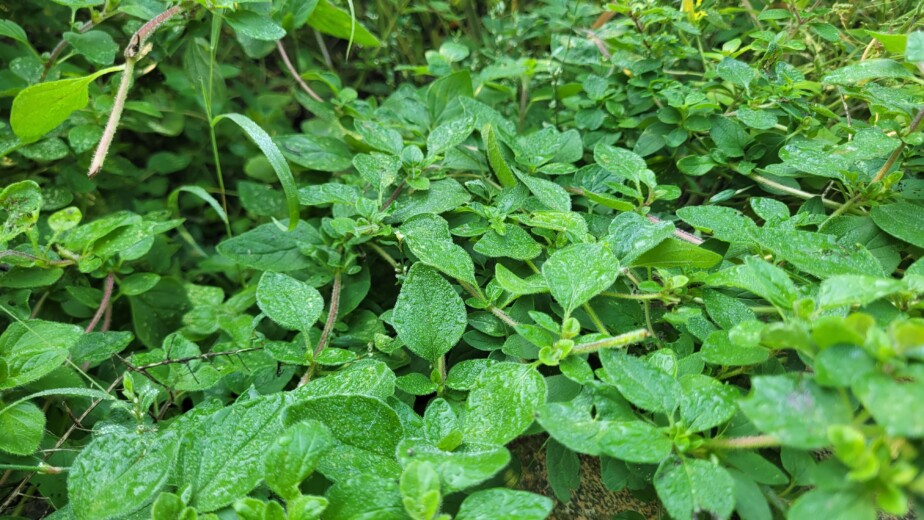
Oregano grows well in rocky soil even though it has a shallow root system. Oregano is very drought-tolerant and mines the soil for nutrients even in poor conditions. It tolerates slightly acidic or alkaline soil pH.
Organo has cute ‘spade’-shaped leaves. Baby leaves grow next to big ones, and it’s a rather attractive-looking growth pattern. The plant as a whole is a cute mounding shape and gets bigger for us every year. Growing up to a foot and a half in height.
Since it tends to spread out a bit, it’s also a great ground cover.
Oregano seeds available.
The fragrance of oregano is also a joy in the garden and a highly used herb in cooking.
After a couple of years of establishment, oregano will grow bigger where there is room. Before you know it, you’ll have too much to dry on the dehydrator and more than enough to supply you with a year’s worth of seasoning.
Pollinators are attracted to the taller flowers when they bloom.
Deer have eaten some of our oregano, but they don’t chomp back the whole plant, just a couple of small bites and they move on.
Oregano also has some powerful medicinal properties that are worth having around. Plus, we use it for all sorts of meals—Mexican, Greek, and Italian-inspired foods.
Marjoram (Zones 4-9)
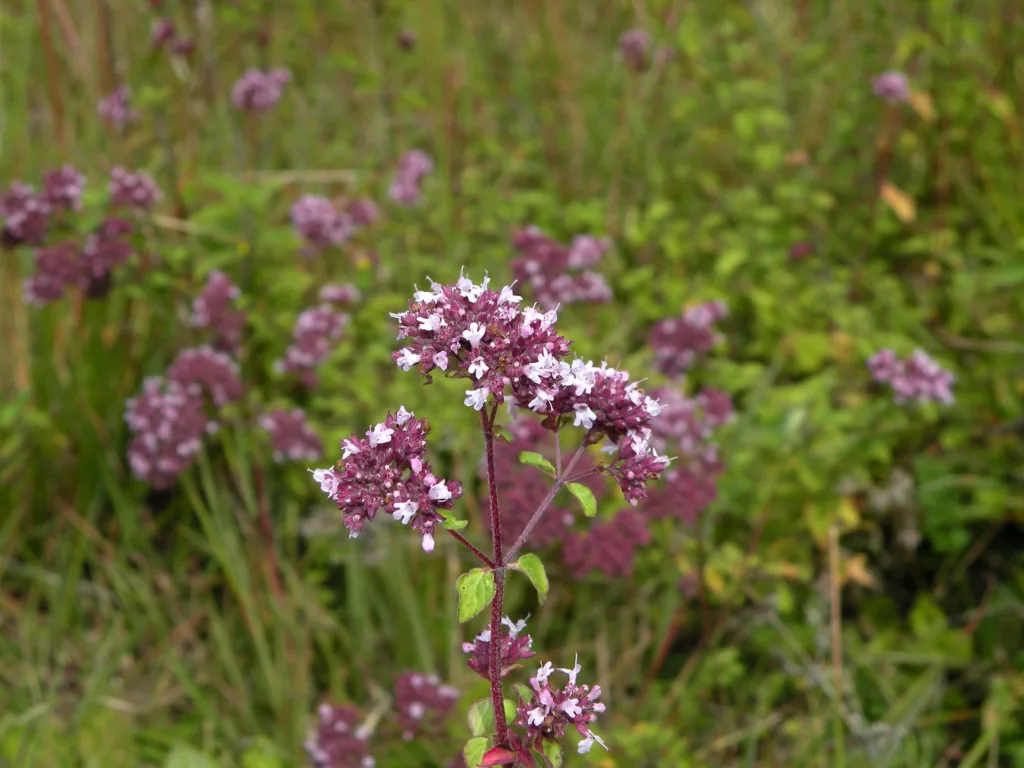
Marjoram is another shallow-rooted herb that adapts to limited water and retains moisture in its leaves.
Even in poor conditions, marjoram will find what it needs to live.
Marjoram features small but bright green oval leaves and purple/white flower spikes. It’s often used in marinades for all sorts of meats, fish, or vegetables.
It’s generally similar to oregano including the way it bushes out into a round shape. Marjoram appears more compact and brighter in color.
Its spreading nature suppresses weeds from germinating and growing.
The compounds present in marjoram can help deter cabbage worms, bean beetles, aphids, and more. Like other herbs, it’ll attract beneficial insects as well, such as predators, and pollinators.
Marjoram seeds available.
Chives (Zones 3-10)

Chives are gorgeous. I love looking at those purple flowers among the various tones and textures of green.
Chives, however, spread quickly and easily by seed. If you don’t wish to have chives all over the place, ensure you cut back the flowers before they expire—before the seed matures.
This flavorful and versatile fresh food topping is extremely easy to grow. Chives are highly adaptable to various soils and have a relatively shallow root system.
Conserving water in the grass-like leaves helps with adapting to generally dry spots and drought tolerance.
Chives look like lush, dark, round grass with purple pompoms when in flower. They taste wonderful when added fresh on meals as a garnish.
They attract beneficial pollinators and predators while deterring pests as do all alliums.
Chive seeds available.
Lemon balm (Zones 4-9)
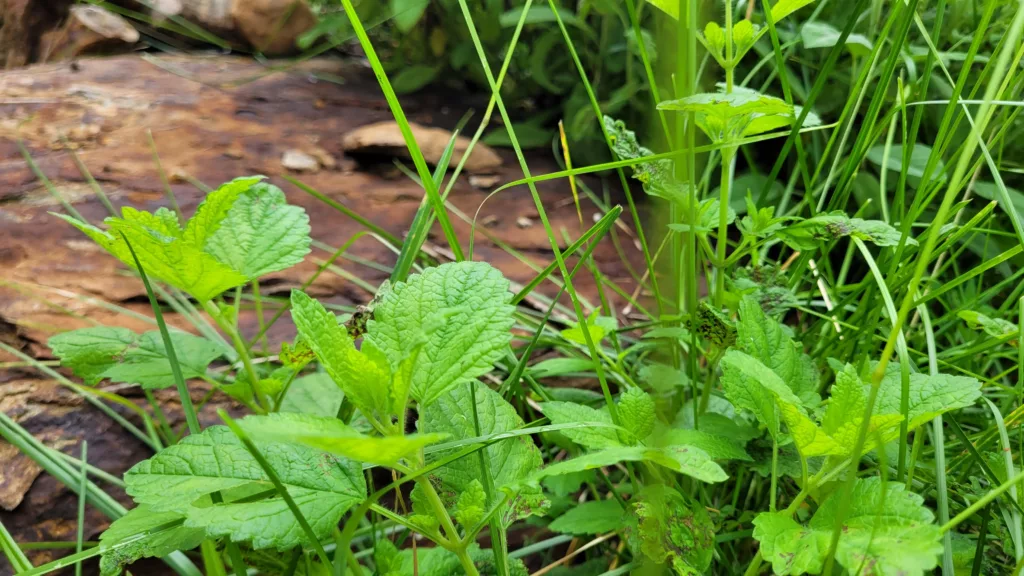
Lemon balm is easygoing. It doesn’t require high amounts of fertility and is adaptable to most soils. Drought tolerance and a strong will to live allow lemon balm to thrive in rocky soils even with shallow roots.
Bright green heart-shaped foliage is an attractive feature to look at but beware, deer aren’t afraid to chop this down. If they do, it’s likely to grow back and be less of a snack choice next time.
When in bloom, pollinators enjoy pale yellow or white flowers. All season, pests are deterred by the strong lemon scent.
Personally, we haven’t used lemon balm much. Not nearly as much as the other herbs.
But if you love the flavor of lemon, this herb is commonly used in tea, salads, desserts, cold drinks, and more.
Lemon balm seeds available
Spearmint & Peppermint (Zones 3-11)
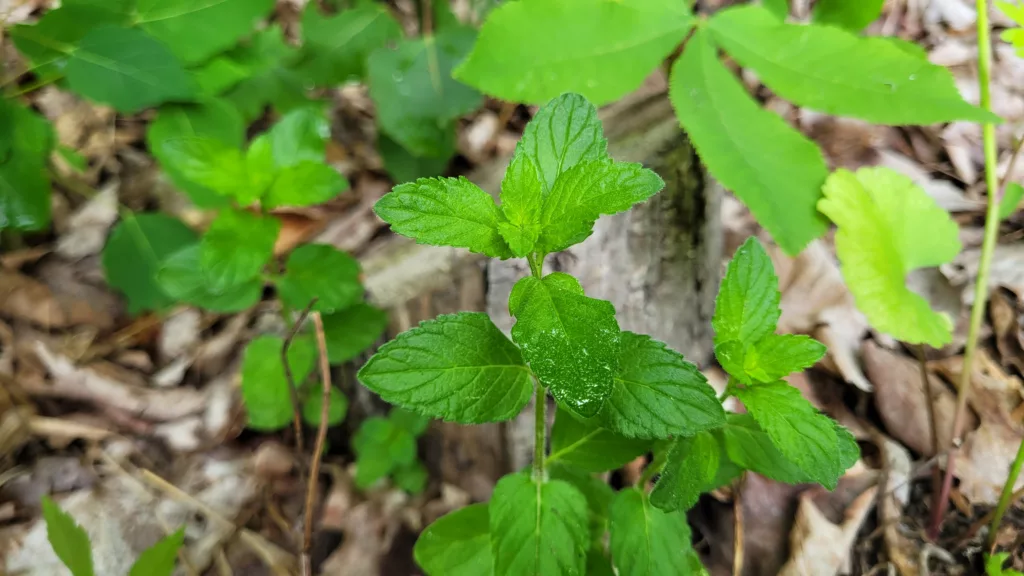
Peppermint is my favorite, hands down. I love it for hot tea, a fresh summer sprigg makes the most delicious peppermint tea you’ll ever try. Spearmint is a wonderful refresher in drinks and fruit salads.
Both these mints thrive in rocky soils as they have runners that creep around to all the available places. With shallow roots and spreading runners, they don’t tend to suffer during droughts.
Spearmint is bright green in appearance while peppermint is dark green.
Both are great for calming an upset stomach and have other wonderful medicinal qualities.
Beware that mint has a tendency to become invasive as their runners basically go on forever. If you are consuming the plant, however, this has never been an issue for us!
Our peppermint actually suffered from over-harvesting and it didn’t look well enough the following year to pick from. So we left it. It is making its way to other places, but we put it in a spot that we don’t mind it spreading from.
Peppermint and spearmint seeds available.
Dill (Zones 2-11)
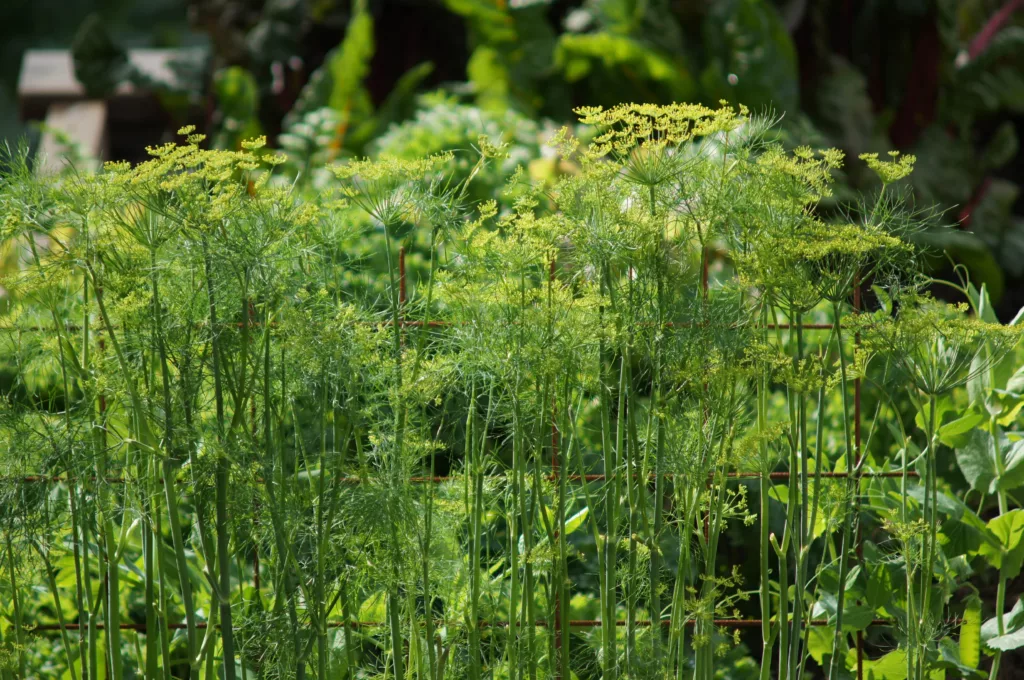
Dill is an annual herb, it grows well in rocky soils because of its taproot. Taproots are long roots that grow down and deep into the soil where nutrients and water are more abundant.
Dill is best sown from seed and grows very fast. After flowering it tends to self-sow in place and other spots. It’s an annual, so if it grows anywhere you don’t want it, simply cut the flowers back so it doesn’t reseed.
Dill has a feathery appearance, similar to asparagus if you’ve seen them. When in flower, they have yellow umbels, that are shaped like umbrellas.
These attract tons of pollinators. Dill would be perfect on a rocky border near a vegetable garden with cucurbits, brassicas, or nightshades.
Dill seeds available.
Savory (Zones 4-11)

For shallow rocky soils, savory is the final recommendation for this soil type. Any plant in this post, however, will thrive in deeper rocky soils.
Savory is adapted to nutrient-poor soils—it’s about the only thing that grew in the annual garden that we received terribly deficient soil one year!
We grew summer savory, but you can grow either summer or winter savory. (We want to grow winter savory too, but haven’t yet!)
Summer savory is an annual, like dill, and winter savory is a perennial. Winter savory withstands colder temperatures while summer savory, savors the warm sunny weather!
Summer savory grows best in zones 4-11 during the right seasons in each climate. You’ll need to start from seed indoors earlier to get enough growing time during summer for a harvest in colder zones.
Winter savory grows best in zones 6-8 and will come back every year for years, like any typical perennial.
10 best herbs to grow in rocky soils
Some of these herbs may also grow in shallow rocky soils chamomile and wintergreen are the most likely, but not having done so myself, you’ll have to try it out for yourself! And what you think of as shallow rocky soil may be different from what I think of when saying shallow rocky soil!
So understanding the depth in which roots grow is something you can consider when planting! Overall, this whole list includes pretty tough herbs that aren’t generally fussy.
Parsley (Zones 3-9)
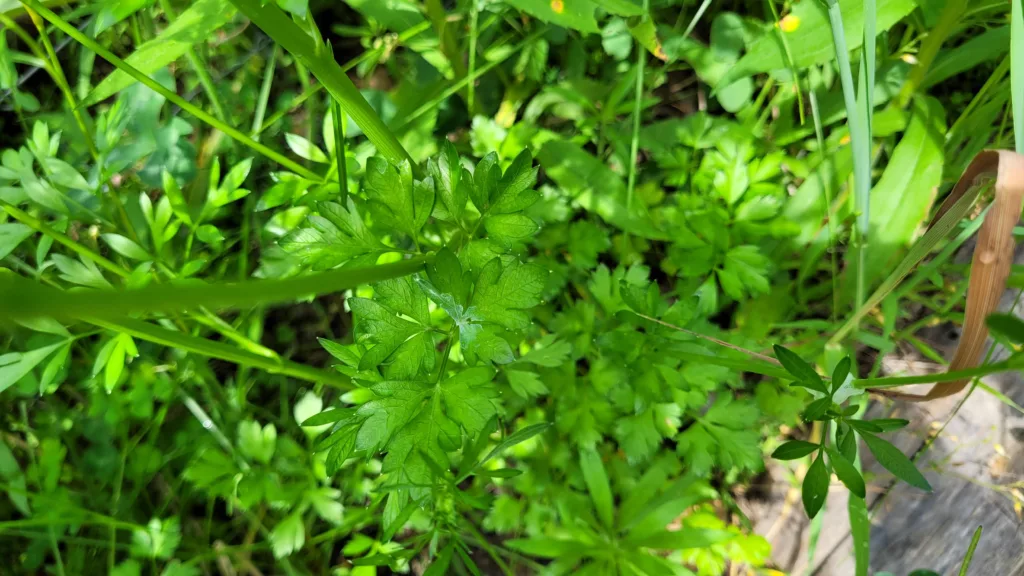
Flat-leaf and curly-leaf parsley can both grow well in deeper rocky soils. I prefer flat-leaf parsley for eating myself, but you can order either seed here.
I love parsley-heavy salads, as not common as that seems, with enough lemon, red onion, and cucumber, it’s incredibly nutrient dense and delicious!
Lavender (Zones 5-8)
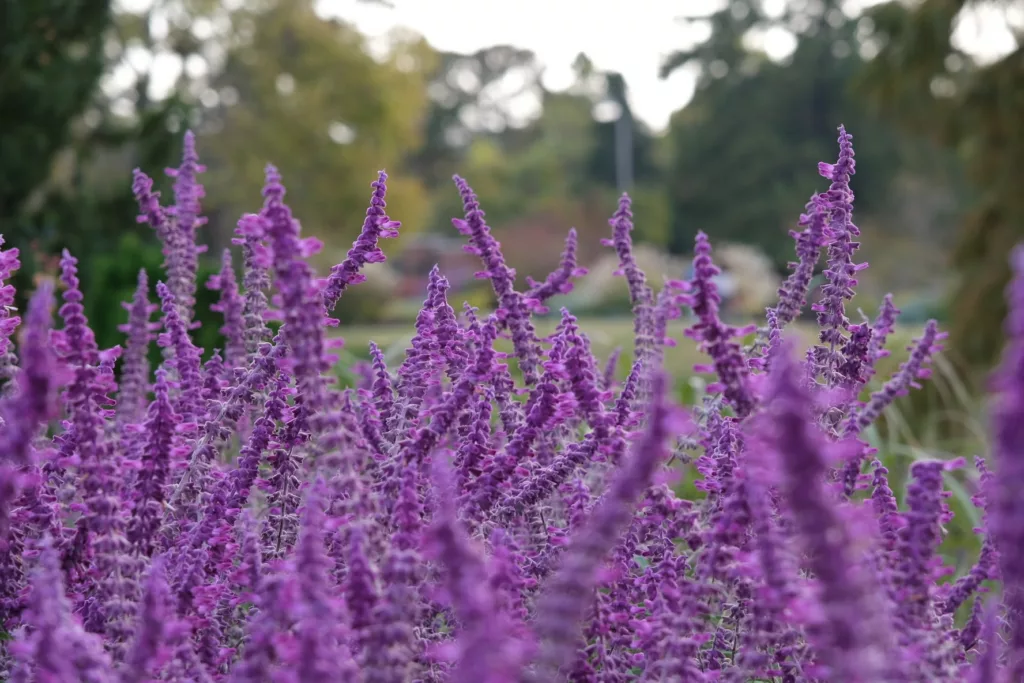
Lavender foliage is very similar looking to rosemary. But they smell quite different and offer a whole new world of uses.
We grow lavender from seed since we want a bunch and they don’t all survive in every place we have to offer them. Rocky areas have been the best for lavender since we live in zone 5, the bottom cusp of its cold tolerance.
Rocks retain the heat and help lavender survive cold and potentially windy winters.
Tarragon (Zones 4-8)

Tarragon is one we haven’t personally grown, but other gardeners who use this herb, have them growing in various soils, including rocky soil.
This herb is often used similarly to basil or mint. Otherwise, it goes well with citrusy flavors and is used most in French cuisine.
Tarragon seeds available.
Chamomile (Zones 3-9)
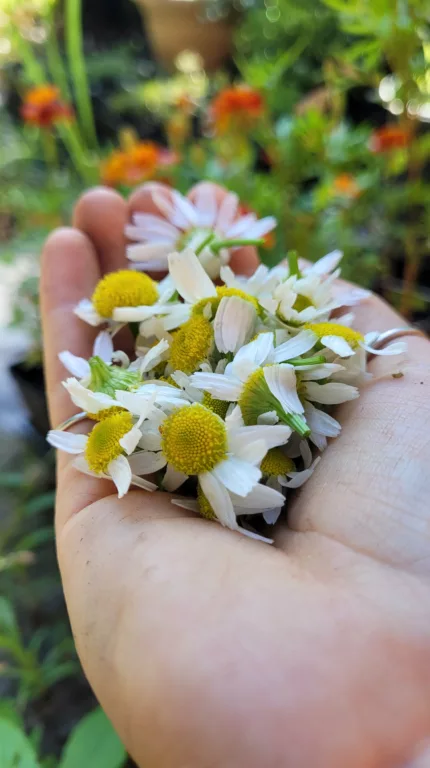
Roman chamomile is perennial, and German chamomile is annual. Roman chamomile grows in zones 4-9 and German can be grown in zones 2-9.
Both Roman and German chamomile tolerate rocky soil very well. They are also known for thriving in poor soils.
You might have success with chamomile in shallow rocky soil, but it depends on how shallow. Chamomile roots grow up to 6 inches deep.
Chamomile has cute daisy-like flowers that bloom continuously for weeks! We harvest bits every 1-2 days while they bloom for drying so we can have homegrown chamomile tea year-round.
The plant grows feathery foliage up to 2 feet tall. I like growing chamomile as a companion to brassicas, cucumbers, and fruit trees.
Wintergreen (Zones 3-8)
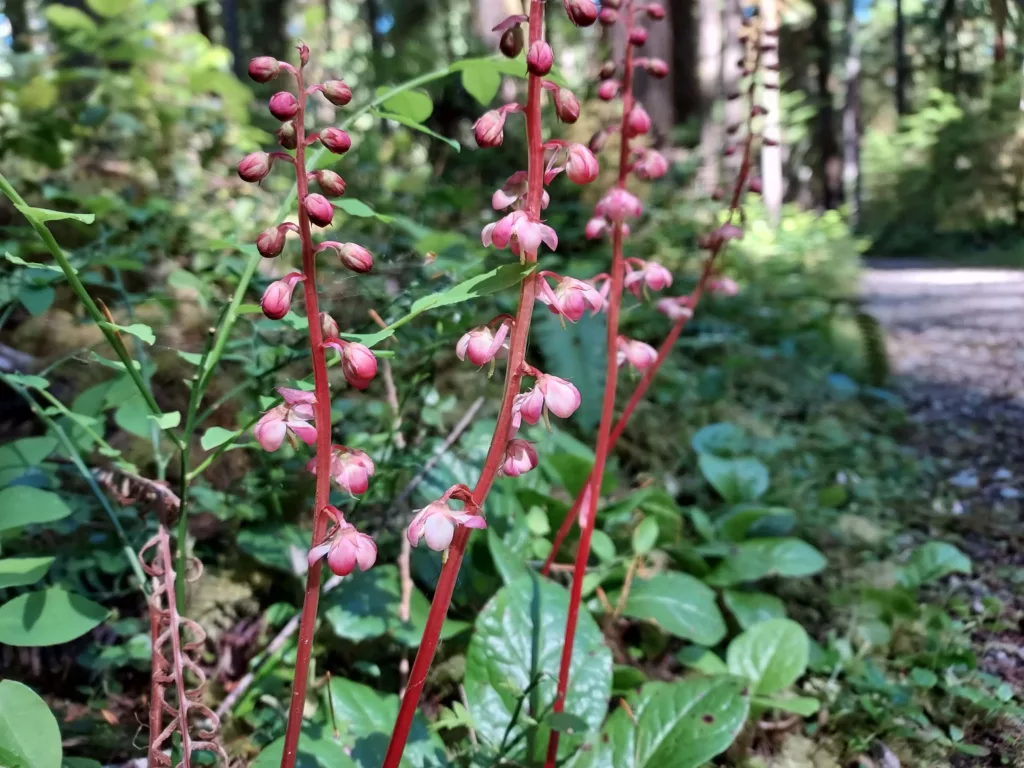
Wintergreen grows naturally all over our rocky areas. So I couldn’t tell you that it doesn’t!
It’s a wonderfully fragrant herb with cute, dark, and glossy leaves. The berries on this plant are small and red and stay on through winter.
The plant smells like your classic wintergreen bubble gum. But sadly tastes bitter and bland rather than that sweet mint.
Wintergreen added to a peppermint tea, however, is very nice! You get the wintergreen aromas and added medicinal anti-inflammatory benefits.
It only grows 4-8 inches tall and has a spreading habit making it a good ground cover.
A spreading habit is good for erosion prevention.
Seeds available here.
Lovage (Zones 4-9)
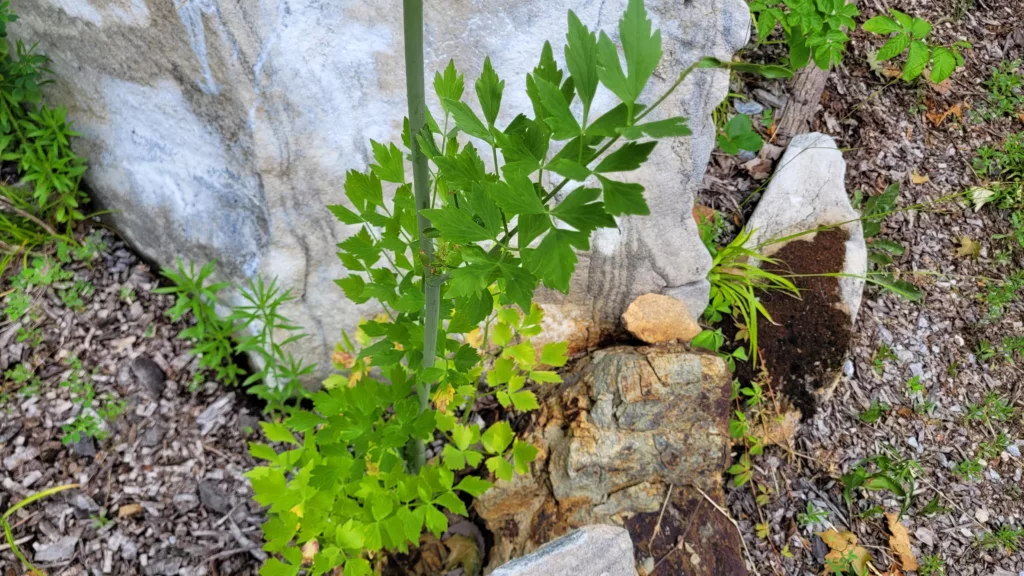
Lovage is tall. Up to 6 feet tall!
It’s lemony in flavor and very strong. So a little goes a very long way.
But lovage grows in rocky soil very well for us.
The leaves look like parsley or celery. You can companion plant lovage to help deter pests that love carrots, tomatoes, or peppers. I recommend you keep it on the sidelines, perhaps in that rocky area you’re looking to fill. They grow quite quickly and have no trouble taking up room.
Lovage seeds available.
Lemon verbena (Zones 8-10)
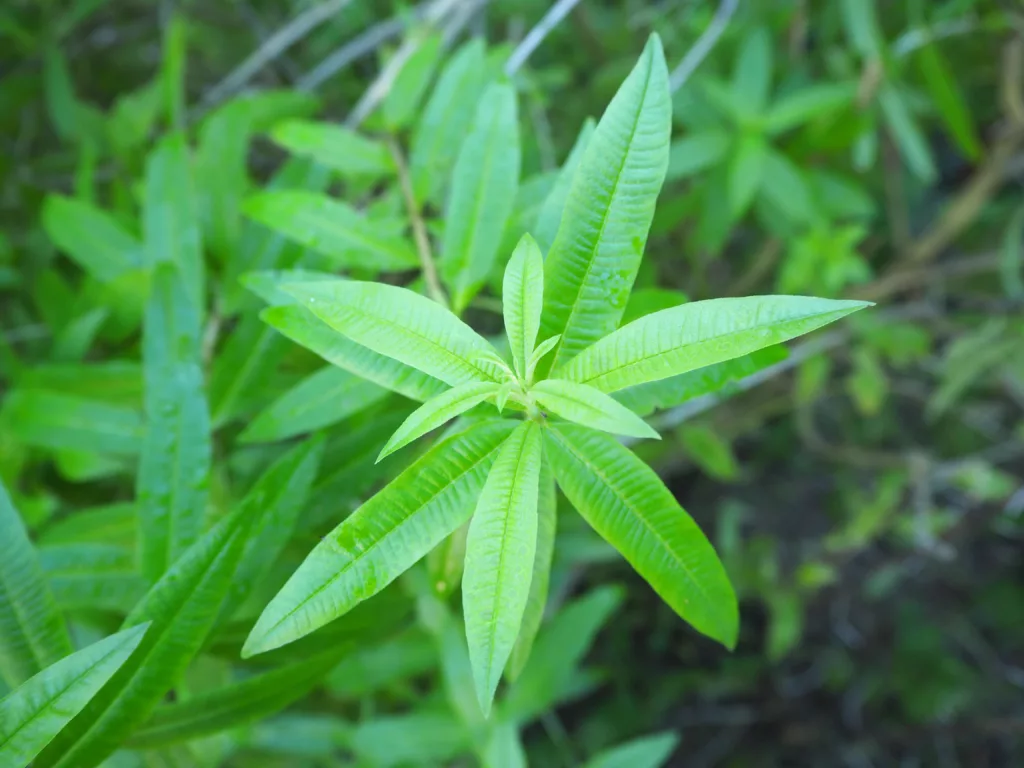
Lemon verbena prefers good drainage and is known for drought tolerance.
Those in warmer climates can grow this plant. You may, however, grow this as an annual in colder zones.
It has striking bright green long leaves and a woody stem.
It’s been said to enhance the flavor of tomatoes if growing nearby. I have no anecdotal experience to confirm this claim.
Catnip & Catmint (Zones 3-9)
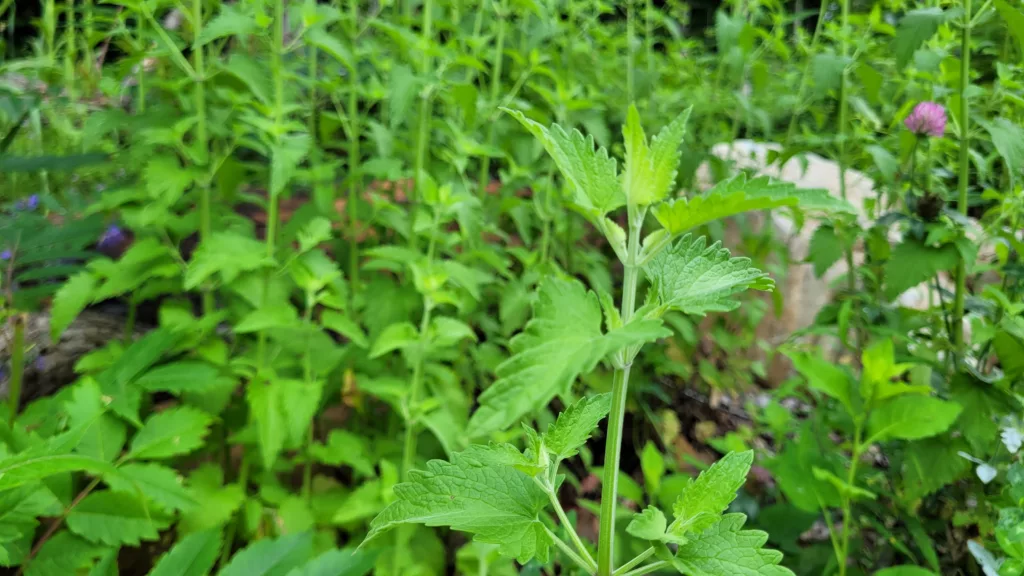
We have several catnips and catmints growing in various places.
They seem to thrive anywhere, but are big plants! And they’ll wish for plenty of room.
If you have a space to fill and rocky soil, catmint makes for a delicious tea! And your cats will love catnip, but so can you.
Catnip is more of an acquired taste but does have benefits for both you and your cats!
Catmint and catnip seeds available here.
Rue (Zones 4-9)
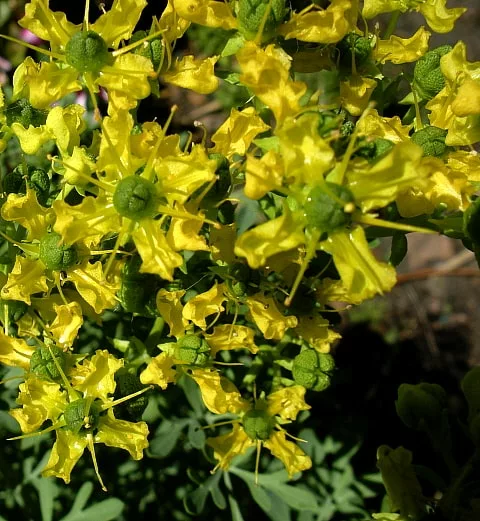
Rue has an extensive root system and thrives regardless of droughts once established.
It features bright yellow flowers attracting beneficial insects and deterring pests with its strong fragrance.
Rue is said to enhance the flavors of vegetables when planted nearby. I have no anecdotal experience to confirm these claims.
Conclusion
All of these plants have a few things in common.
- They make good companions to ward off pests
- They attract pollinators and predators
- They have some degree of drought tolerance
- Are generally adaptable
- And are all fragrant and useful!
Well-spaced rocks, larger rocks, a slope in the land, and good soil structure allow what to drain freely.
This is why most of the plants on this list are drought tolerant because they’d need to be in order to live in good draining rocky soil.
But, not all rocky soil is necessarily great at draining.
Shallow bedrock, fine particles (clay), and a flat surface in a low area will cause very poor draining soil. If this is the type of rocky soil you’ve got, we have a section of it too!
These articles might help:
Up Next:
Recent Posts
There’s no shortage of full-sun ground covers for zone 4 climates! Each plant in this list can withstand the frigid temperatures and also enjoy the hot sun in summer. Full sun means that a plant...
There's no shortage of full sun ground covers, not even in zone 3! Zone 3 climates offer hot but short-lived summers and very cold winters. So each plant in this list can withstand the frigid...
